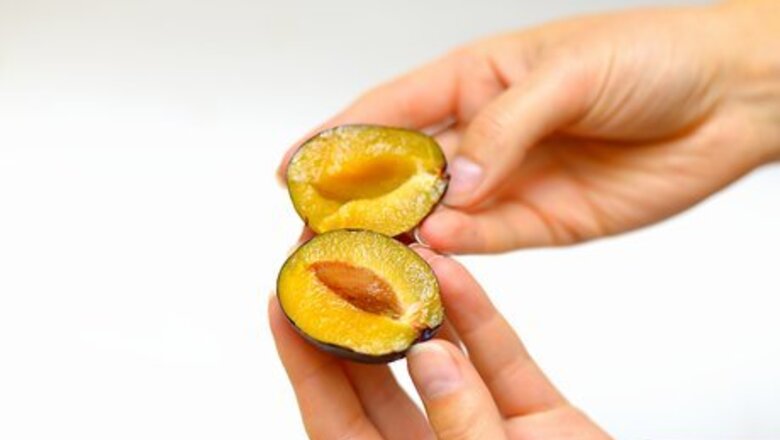
views
Using an Oven

Cut your plums and remove the pits. Slice the plums in half around the pit, working with a small, sharp knife. Pull the halves apart, remove the pit, and discard the pit. Make sure you work with a knife small enough to handle. A large knife is not appropriate for cutting plums.

Place the plums directly on the oven rack. Do not use a baking pan to make prunes in the oven. A lot of juices will leak from the plums during the drying process. If plums are on a baking pan, they will stick to this surface. Instead, use an oven rack. Make sure to space the plums evenly on the oven rack. If the plums are touching, this may affect the dehydration process. As the process can make a mess on the bottom of your oven, consider setting something down to catch the drippings. Some people find success laying a single sheet of foil on the bottom of the oven. However, the foil may melt and it does not work for gas ovens. You could try lining a baking tray with foil and setting that under the plums.

Set the plums in the oven at 200 degrees Fahrenheit. You should set the oven as low as possible. For most ovens, that is 200 degrees Fahrenheit. If your oven is different, simply set the oven to the lowest possible temperature. Make sure to place the oven rack in the oven slowly. You do not want to knock the plums around.

Check the plums every few hours. You should flip the plums every few hours so they dry out evenly. You should also check on how the dehydration process is coming along. You want your prunes to be slightly soft and juicy, while also being dry to the point of having a wrinkled, dark appearance. This also depends on personal preference. Some people prefer prunes slightly dryer while some prefer them juicier. Do not remove the prunes until they're at your desired state.

Heat your prunes for around 8 hours. While most prunes will be ready at this point, vigilant checking is important. Some prunes will be ready sooner than 8 hours, and some will need a little more time. The prunes will probably be ready at slightly different rates. Remove them as needed.
Using a Dehydrator

Cut your plums and remove the pits. Remove the stem. Then, cut the plum in half around the pit using a sharp pairing knife. Pull the two halves of the plums apart. Remove the pit and discard. If you don't have a pairing knife, you can use another sharp knife. However, be sure to avoid a large knife. Plums are small, and you want to make sure you maintain control of your knife as you cut around the pit.
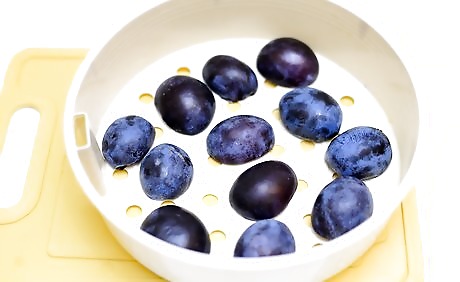
Lay the plums on your dehydrator tray. It's a good idea to push the plums close together, as this will eliminate the need to do two batches. However, make sure the plums are not touching. This is important for air circulation, which allows the plums to dry properly.

Place the tray in the dehydrator. You should dehydrate your foods at 115 °F (46.1 °C) when working with a conventional dehydrator. However, if you have an excalibur dehydrator, start out at 145 degrees. Make sure the dehydrator is at the right temperature before placing the plums in the oven. Place the tray in the dehydrator slowly to avoid knocking the plums together.

Check the plums every 4 to 6 hours. You want to turn the plums at some point to complete the dehydration process. Check every 4 to 6 hours to see if the plums are ready to turn. When plums are ready to turn, the upside should be very dry. The plums should release easily from the tray. If the upside of the plum is still moist, and the plum does not come off easily, leave the plums for a bit longer before turning them.
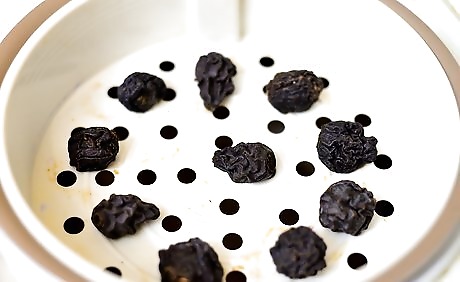
Check every 2 hours when you begin removing prunes. The plums will turn into prunes at different rates. When you notice some plums completely lack moisture, they've completed the pruning process. These should be removed from the dehydrator. After this, start checking on the plums ever 2 hours, as they're getting close to being done.
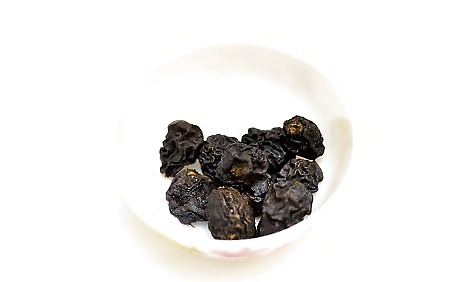
Allow the plums to dehydrate for 14 hours. Plums will take roughly 14 hours to fully dehydrate. However, they may take longer or shorter depending on the quality of the plums. This is why it's important to check your plums regularly during the dehydrating process. When fully dehydrated, you will have black, wrinkled, raisin-like prunes.
Storing and Eating Your Prunes

Store your prunes properly. Dried prunes should be placed in an airtight container. A heavy duty plastic bag is also appropriate. You can store prunes in a cool, dark area. Prunes can be safely stored in the pantry, the refrigerator, or the freezer.
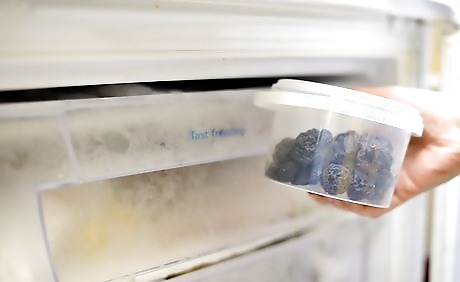
Discard prunes after they spoil. The shelf life of prunes depends on where you store them. Make sure to know the shelf life of your prunes to avoid eating spoiled fruit. In the pantry and fridge, dried prunes will last 6 to 12 months. The freezer can extend the shelf life of a dried prune. Dried prunes stored in the freezer can last 12 to 18 months.

Add prunes to a stuffing. If it's around Thanksgiving, dried prunes can make a tasty addition to any stuffing. When sautéing other items for the stuffing, like onion and celery, toss in the prunes as well. Cook everything together for a few minutes, and then remove the mixture from the heat. Prunes can add a slightly sweet flavor to a stuffing, which can shake up a stuffing made with mostly savory ingredients.
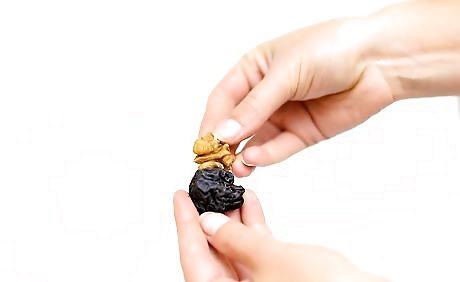
Serve stuffed prunes as an appetizer. You can stuff prunes with Stilton or another type of cheese for a sweet and savory appetizer. You simply cut the prunes through the center and then fill them with cheese. Stuffed prunes would make a great snack for an elegant dinner party.

Garnish a pot roast with prunes. Prunes can compliment beef nicely. Usually, you would add the prunes, in addition to any other garnishes, about halfway through the cooking process. However, refer to your specific recipe to make sure this is safe given the type of roast you're making.

















Comments
0 comment